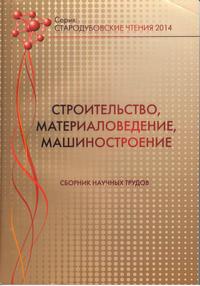Research of the heterogeneous alloy properties via indentation and finiteelement method simulation
Keywords:
Heterogeneous alloys, deformation, modeling.Abstract
The energy exchange processes in heterogeneous alloy 30%Co-70%WC were studied via microindentation and FEM. The indentation shown that alloy dissipated 271±45.4 nJ of absolute possible 463±49.8 nJ and recovered 62±4.1 nJ. The results of FEM proved that high effective stress spread in ~26% of hardened volume that laid directly under the imprint. It was also noted that shape of the hardened area tend to form a sphere. It is worth to mentioned that the specific work for elasto-plastic deformation of 1μm3 alloy volume was equal to А=93.68±21.42μJ.References
Fischer-Cripps A.C. The IBIS Handbook of Nanoindentation by A.C. FischerCripps / Fischer-Cripps A.C. – Forestville: IBIS, 2009. – 60 p.
Головин Ю. И. Наноиндентирование как средство комплексной оценки физико-механических свойств материалов в субмикрообъемах (обзор)/ Головин Ю. И. // Заводская лаборатория. - № 1 (75). – 2009. - С.45-59.
Chaudhri M. M. Subsurface strain distribution around Vickers hardness indentations in annealed polycrystalline copper / M. M. Chaudhri // Acta mater. – 1998. – Vol. 46. – No. 9. – P. 3047-3056.
Zhang W. Finite element analysis of interacting Vickers indentations on brittle materials / W. Zhang, G. Subhash // Acta mater. – 2001. – Vol. 49. – P. 2961– 2974.
Lee J.H. Cohesive interface simulations of indentation cracking as a fracture toughness measurement method for brittle materials / J.H. Lee, Y.F. Gao, K.E. Johanns, G.M. Pharr // Acta Materialia. – 2012. – Vol. 60. – P. 5448–5467.
K.K. Jha Energy-based analysis of nanoindentation curves for cementitious materials/ K.K. Jha, N. Suksawang, D. Lahiri, A. Agarwal // ACI Materials Journal. – 2012. – V.109. – No.1. – P.81-90.
Downloads
Published
Issue
Section
License
Редакція Видання категорично засуджує прояви плагіату в статтях та вживає всіх можливих заходів для його недопущення. Плагіат розглядається як форма порушення авторських прав і наукової етики.
При виявлені у статті більш ніж 25% запозиченого тексту без відповідних посилань та використання лапок, стаття кваліфікується як така, що містить плагіат. У цьому випадку стаття більше не розглядається редакцією, а автор отримує перше попередження.
Автори, в статтях яких повторно виявлено плагіат, не зможуть публікуватися в усіх журналах Видавництва ДВНЗ «Придніпровська державна академія будівництва та архітектури».
Автори, які публікуються у цьому журналі, погоджуються з наступними умовами:
- Автори залишають за собою право на авторство своєї роботи та передають журналу право першої публікації цієї роботи на умовах ліцензії Creative Commons Attribution License, котра дозволяє іншим особам вільно розповсюджувати опубліковану роботу з обов'язковим посиланням на авторів оригінальної роботи та першу публікацію роботи у цьому журналі.
- Автори мають право укладати самостійні додаткові угоди щодо неексклюзивного розповсюдження роботи у тому вигляді, в якому вона була опублікована цим журналом (наприклад, розміщувати роботу в електронному сховищі установи або публікувати у складі монографії), за умови збереження посилання на першу публікацію роботи у цьому журналі.
- Політика журналу дозволяє і заохочує розміщення авторами в мережі Інтернет (наприклад, у сховищах установ або на особистих веб-сайтах) рукопису роботи, як до подання цього рукопису до редакції, так і під час його редакційного опрацювання, оскільки це сприяє виникненню продуктивної наукової дискусії та позитивно позначається на оперативності та динаміці цитування опублікованої роботи (див. The Effect of Open Access).

